
Allan Cunningham was an English botanist and explorer, primarily known for his travels in Australia to collect plants.
Kmart Australia Limited is an Australian-based chain of affordable retail stores owned by the Kmart Group division of Wesfarmers. The company operates 323 stores across Australia and New Zealand, with its head office located in Mulgrave, Melbourne. Kmart Group, the department store division of Wesfarmers, also owns and operates Target Australia and online retailer Catch.com.au.

Grevillea robusta, commonly known as the southern silky oak, silk oak or silky oak, silver oak or Australian silver oak, is a flowering plant in the family Proteaceae. It is a tree, the largest species in its genus but is not closely related to the true oaks, Quercus. It is a native of eastern coastal Australia, growing in riverine, subtropical and dry rainforest environments.

Centipeda cunninghamii is a species of flowering plant in the Asteraceae family. It is referred to by the common names old man weed, being the literal translation of its Koori name gukwonderuk, common sneezeweed and scent weed which were given by European settlers but are increasingly falling out of use. The plant was used by indigenous Australians for its purported medicinal properties. It grows along the Murray River, or generally anywhere there is water, especially low lying or swampy areas. It can be identified by its unique shaped leaf and its pungent scent which is pine-like and minty.

Corokia is a genus in the Argophyllaceae family. The genus was first described in 1839. It comprising six species native to New Zealand, Australia and Rapa Iti. Corokia species are shrubs or small trees with zigzagging (divaricating) branches. In fact, Corokia cotoneaster is commonly known as wire-netting bush. The stems of the shrubs are dark when mature, covered with downy or silky hairs (tomentum) when young. In spring, they produce clusters of small, star-shaped yellow blossoms. Berries are red or yellow. The shrubs prefer forests and rocky areas, sun or light shade, reasonably well drained soil, and moderate watering.

Alsophila cunninghamii, synonym Cyathea cunninghamii, also known as the gully tree fern and slender tree fern, is a species of tree fern indigenous to New Zealand including North Island, South Island and Chatham Islands; also to Victoria, possibly New South Wales, southeastern Queensland and Tasmania in Australia. It grows in damp forest, often emerging from stream gullies and riverbanks. Brownsey noted that it has a lower tolerance for drought than other related species. The erect trunk may be 20 m tall and is usually 6–15 cm in diameter, occasionally as much as 20 cm. Fronds are tri- to tetrapinnate and 3 m or more in length. The rachis and stipe are slender, black brown, warty and covered with brown scales. Sori occur along each side of the pinnule midvein and are covered by hood-like indusia. A. cunninghamii is an uncommon and slow-growing tree fern.
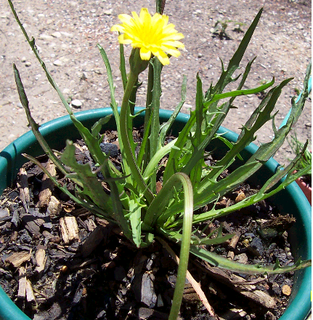
Microseris scapigera is a yellow-flowered daisy, a perennial herb, found in New Zealand and Australia. It is the only New Zealand species of Microseris, and one of three Australian species along with Microseris lanceolata and Microseris walteri. It is classified in a group of plants, the tribe Cichorieae, that includes chicory and dandelion.
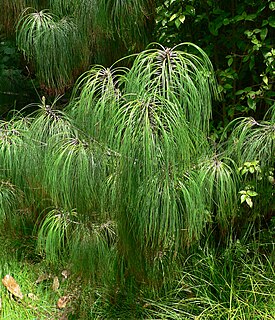
Pinus pseudostrobus, known in English as the smooth-bark Mexican pine and in Spanish as chamite or pacingo, is a tree found in forests of Mexico and Central America. It is 8 to 25 m tall with a dense and round top.It is threatened by logging and wood harvesting. The bark is brown and fissured and smooth when young. It is subject to ex-situ conservation. It grows at altitudes between 850 and 3250 m. from 26° to 15° north latitude, from Sinaloa, Mexico to Nicaragua and Honduras. It occurs within a rainfall regime that rains mostly in summer.
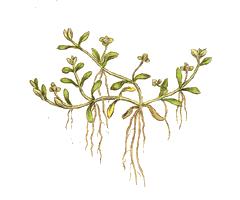
Elatine is one of only two genera in the plant family Elatinaceae, the waterwort family. It contains about 25 species of aquatic plants known generally as waterworts. These are annual or perennial plants found in wet areas worldwide.

Grevillea iaspicula, commonly known as Wee Jasper grevillea, is a species of endangered shrub that is endemic to southern New South Wales.

Crotalaria cunninghamii, also known as green birdflower, birdflower ratulpo, parrot pea or regal birdflower, is a plant of the legume family Fabaceae, named Crotalaria after the Greek word for rattle, because their seeds rattle, and cunninghamii after early 19th century botanist Allan Cunningham. Crotalaria cunninghamii is a short-lived perennial plant native to Australia and its habitat is the deserts, coastlands, drainage lines and sand dunes of the northern half of Western Australia and the Northern Territory. This habitat is semi-arid to temperate regions in well drained soils. Crotalaria cunninghamii blooms from January to April. It is pollinated by large bees and by honeyeaters. Crotalaria cunninghamii is known as the Mangarr plant to the Nyangumarta Warrarn indigenous group.

Poa foliosa is a species of tussock grass commonly known as muttonbird poa. It is native to the subantarctic islands of New Zealand and Australia.

Cardamine corymbosa, commonly known as the New Zealand bitter-cress, is a flowering plant in the family Brassicaceae. Native to the subantarctic islands of Australasia, it has become an invasive species in plant nurseries. The specific epithet refers to the structure of the inflorescence.
Ackama is a genus of flowering plants in the family Cunoniaceae, native to Australia and north New Zealand. The genus was first described by Allan Cunningham in 1839.

Epilobium pedunculare, the rockery willowherb, is a species of Epilobium similar to E. brunnescens. It is found on the Antipodean Islands, Chatham Island, Macquarie Island, and both the North and South Island of New Zealand.
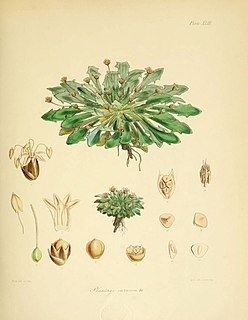
Plantago triantha is an annual plant of the family Plantaginaceae that is found in both Tasmania and the Auckland Islands.

Juncus antarcticus, also known as dwarf rush, is a flowering plant species in the rush family Juncaceae, native to New Zealand and Australia.
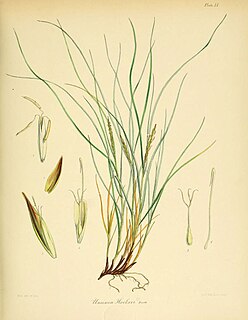
Carex erebus is a member of the sedge family and is found on the Antarctic Islands of Australia and New Zealand.

Elatine hydropiper is a species of flowering plant belonging to the family Elatinaceae.
Elatine triandra is a species of flowering plant belonging to the family Elatinaceae.

















